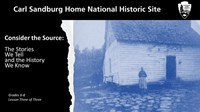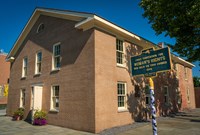- Lesson Plan (40)
- Distance Learning (37)
- Field Trips (23)
- Student Activities (10)
- Guest Speakers (3)
- Field Schools & Institutes (2)
- Primary Sources (2)
- Teacher Reference Materials (2)
- Acadia National Park (16)
- Fort Scott National Historic Site (4)
- Shenandoah National Park (4)
- Everglades National Park (3)
- First Ladies National Historic Site (3)
- Carl Sandburg Home National Historic Site (2)
- Cuyahoga Valley National Park (2)
- Delaware Water Gap National Recreation Area (2)
- Denali National Park & Preserve (2)
- Show More ...
- Social Studies (72)
- Science (55)
- Literacy and Language Arts (27)
- Math (7)
Showing 111 results for Wesleyan Chapel ...
"We Proceeded On..."
- Type: Lesson Plan
- Grade Levels: Upper Elementary: Third Grade through Fifth Grade
Students will learn about maps and what information can be gathered from them through the use of maps of the lower Columbia River. Using math and timing their own walking speeds students will be able to determine how long it would take to drive from one location to Fort Clatsop, walk to Fort Clatsop, and how much that would cost.
We Want You!
- Type: Student Activities
- Grade Levels: High School: Ninth Grade through Twelfth Grade

At the start of the U.S.-Mexican War, both Mexican and U.S. citizens mistrusted a standing army. In this activity, students discuss reasons for joining an army. Next, they discuss the differences between a regular army and a militia of volunteers. Then they review and discuss U.S. and Mexican perspectives on regular and volunteer soldiers.
We The People: Life at a Frontier Fort
We the People: Challenges of Life at a Frontier Fort
Revolutionary Roots: the First Women’s Rights Convention held at the Wesleyan Chapel in Seneca Falls, NY
- Type: Distance Learning
- Grade Levels: Upper Elementary: Third Grade through Fifth Grade
What Happens to the Water When We Brush and Flush?
- Type: Lesson Plan
- Grade Levels: Middle School: Sixth Grade through Eighth Grade

Water from homes and businesses enters sewers or septic tanks through pipes. This wastewater is kept with other dirty water because it is unhealthy and must be kept away from our drinking water. This sewer water is sent to a water treatment plant where the unhealthy parts are removed. The water is then returned to the river sometimes cleaner than it was originally. This lesson raises real world concerns, guiding students to become better stewards of our environment.
We Have a Story to Tell: Native Peoples of the Chesapeake Region
- Type: Teacher Reference Materials
- Grade Levels: High School: Ninth Grade through Twelfth Grade

This lesson primarily covers the period from the early 1600s to the present. Students explore how colonial settlement and the establishment of the United States affected the Native Americans of the Chesapeake region, especially the Powhatan, Nanticoke, and Piscataway peoples. Students will learn about the forces that resulted in the eradication of some tribes and how others survived.
Consider the Source: The Stories We Tell and The History We Know (Grade 6 -8) Lesson 3 of 3 Carl Sandburg Home NHS
- Type: Lesson Plan
- Grade Levels: Middle School: Sixth Grade through Eighth Grade

This is the 3rd of 3 lessons designed to contribute to middle school student's working knowledge of Black history in Western North Carolina (W.N.C.) and to give them the skills to identify common myths of the region as well. This lesson introduces critical thinking concepts such as anachronisms and explores myths and deferred histories from W.N.C. This lesson is intended to exercise historical thinking skills and encourage the dialogue studied in previous lessons.
Perspectives After the Surrender at Appomattox CH
- Type: Lesson Plan
- Grade Levels: Middle School: Sixth Grade through Eighth Grade
This program will allow students to think about the different perspectives of those who lived through the Civil War, and how various viewpoints interpreted the events surrounding the Surrender Meeting at Appomattox. This program consists of several assignments designed to help students explore these differences through the stories of three people present at Appomattox Court House in 1865.
What can we learn about the lives of enslaved people from primary sources?
- Type: Primary Sources ... Student Activities ... Teacher Reference Materials
- Grade Levels: Upper Elementary: Third Grade through Fifth Grade
Consider the Source: The Words We Mean: An Exercise and Study on Euphemisms, Language, and Dialogue about Chattel Slavery in Western North Carolina and the United States (Grades 6-8) Lesson 1 of 3 Carl Sandburg Home NHS
- Type: Lesson Plan
- Grade Levels: Middle School: Sixth Grade through Eighth Grade

This is the 1st of 3 lessons designed to contribute to middle school student's working knowledge of Black history in Western North Carolina. This lesson introduces students to the language of Black history and its relevance to their own dialogues and historical skills. With multiple interactive opportunities, and historical and artistic sources, students will develop language arts and critical thinking skills.
Archeology at Fort Stanwix, On-Site Education Program
Today and Yesterday: Comparing Cultures
- Type: Lesson Plan
- Grade Levels: Upper Elementary: Third Grade through Fifth Grade

In this lesson we will compare some of the tools that the Hopewell used to satisfy their basic human needs to the ones we use for our needs today. We will talk briefly about why the tools in past might serve the same function as present day tools but are made from different materials. In the end we will learn that people in the past were not too different than we are now they had the same basic needs in life but were living in a different time and environment.
Agate Fossil Beds Native American Collection
- Type: Distance Learning
- Grade Levels: Upper Elementary: Third Grade through Fifth Grade

Join our Education Rangers as we take a tour of the James Cook Collection of Native American artifacts, we will look inside “A window onto Lakota life” here on the Great Plains. We will also explore how the Bison was sacred to the Lakota and we will learn how the animal played an integral part of their daily lives. And talk about the friendship formed between Chief Red Cloud and a local rancher named James Cook.
Virtual: Grades 3-12: Owls, Natures Nighttime Predators
At Home in Acadia (Kindergarten)
- Type: Field Trips
- Grade Levels: Lower Elementary: Pre-Kindergarten through Second Grade
At Home in Acadia (1st Grade)
- Type: Field Trips
- Grade Levels: Lower Elementary: Pre-Kindergarten through Second Grade
At Home in Acadia (2nd Grade)
- Type: Field Trips
- Grade Levels: Lower Elementary: Pre-Kindergarten through Second Grade
Rocky Through Time
- Type: Distance Learning
- Grade Levels: Adult Education

What is the essence of a place? Is it what we can see or what we can hear? Is it solely about that place or also about how a place makes us feel? Explore these topics with a Ranger and discover if cumulative changes in wildlife, wildfires and visitation have changed how we view Rocky Mountain National Park over the past 100 years.








